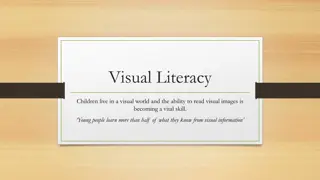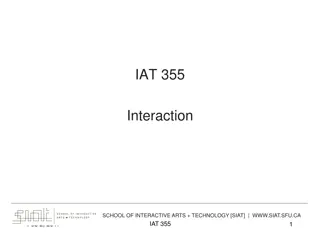Understanding Visual Processing and Visualization
Visualization, defined as the representation of data or concepts in visual form, is an active and constructive process involving both products and processes. Visual processing involves just enough processing to focus on salient stimuli, with attention playing a crucial role. Visual thinking and queries drive the process of tuning the brain's pattern-finding circuits. Explore the interactive nature of visual queries and their problem-solving abilities in this informative content by Dr. Neil H. Schwartz.
Download Presentation

Please find below an Image/Link to download the presentation.
The content on the website is provided AS IS for your information and personal use only. It may not be sold, licensed, or shared on other websites without obtaining consent from the author. Download presentation by click this link. If you encounter any issues during the download, it is possible that the publisher has removed the file from their server.
E N D
Presentation Transcript
VISUAL QUERIES Dr. Neil H. Schwartz
VISUALIZATION: DEFINED Visualization refer to the 2D and 3D static and animated visual displays that depict conditions, situations, processes, places or events as they appear in maps, diagrams, graphs, pictures, schematics, data-based spatial or linear renditions, and immersive virtual environments Active Vision: Thinking about graphics and graphic design as cognitive tools.
ASSUMPTIONS UNDERLYING VISUALIZATION Visualization is an active and constructive process. It is comprised of products and processes. Visualization products are: graphics and the visuospatial layout of graphic designs Visualization products are best conceived as cognitive tools. Visualization processes activate the pattern processing sections of the brain. Pattern processing mean to see a Gestalt entity that is meaningful to the viewer. Visualization is exceedingly fast milliseconds Visualization is shared between internal and external referents.
VISUAL PROCESSING: BASIC IDEAS Visual processing is based on the idea of just enough processing. Salient visual stimuli are sampled Visual processing is based on just-in-time processing. Only important stimuli are processed, but only at the moment you need them. Just-in-time & just-enough processing is provided by rapid scanning -- eye movements within 100 milliseconds. Visual processing requires attention: We are conscious of the field of information to which we have rapid access rather than being immediately conscious of the world.
VISUAL PROCESSING: ITS ALL ABOUT ATTENTION Visual thinking consists of a series of acts of attention, driving eye movements and tuning the brain s pattern-finding circuits. These acts of attention are called: visual queries
VISUAL PROCESSING: JUST ENOUGH-JUST IN TIME Long term Store Working Memory Sensory Buffer External Environment
MORE ABOUT VISUAL QUERIES Visual queries are problem based. Consider the following image:
MORE ABOUT VISUAL QUERIES Visual queries are problem based. Consider this image:
MORE ABOUT VISUAL QUERIES Visual queries are problem based. Finally, consider this image:
THE EYE & THE VISUAL SYSTEM There are two cell types on the retina that detect light. Rods: Three types. Cones: One type.
THE EYE & THE VISUAL SYSTEM Mucula 2.5 3.0 mm Fovea Centralis 0.3 mm at the center 15 degree angle Densely packed cones No Rods
CONES Cones detect color 6-7 million Concentrated in the central yellow spot known as: macula The types of cones are: L Cones absorb wavelengths at 559 nm. M Cones- absorb wavelengths at 531 nm. S Cones- absorb wavelengths at 419 nm.
RODS Detect movement Color insensitive Approximately 120 million
THE NON UNIFORMITY OF OUR VISUAL PROCESSING POWER REVEALS THAT HALF OF OUR VISUAL BRAIN IS DIRECTED TO PROCESSING LESS THAN 5% OF THE VISUAL WORLD . THAT IS WHY WE HAVE TO MOVE OUR EYES. In short, we do not comprehend the world all at once. It just seems that way.
MUSCLES OF THE EYE Responsible for focusing target stimuli on the fovea. Accelerate to an angular velocity of 900 degrees per second. Can stop in less than 1/10 of a second. Movement-stop- movement is termed a saccade . During a saccade, vision is suppressed.
VISUAL PERCEPTION: TWO PROCESSES Top Down Driven by demands of attention. Attention is driven by the needs of the task. Bottom Up Driven by the visual information in the pattern of light falling on the retina.
VISUAL PERCEPTION: TOP DOWN - BOTTOM UP
VISUAL PERCEPTION: HOW IT WORKS BOTTOM UP Feature Detection Pattern Segmentation Pattern Comprehension
VISUAL PERCEPTION: BOTTOM-UP http://gazzaleylab.ucsf.edu/files/top-down%20brain.jpg More neurons (90%) devoted to feature processing--5 billion neurons form a parallel processing system to operate on information from one million fibers in the optic nerve. Feature detection pulls out: Size & orientation Red-green & yellow-blue differences Motion and depth Pattern recognition parses visual information into regions of texture and color. Pattern comprehension occurs by comparing in visual working memory to previously-known shapes & object in the long-term store.
VISUAL PERCEPTION: HOW IT WORKS BOTTOM-UP TOP-DOWN http://gazzaleylab.ucsf.edu/files/top-down%20brain.jpg






















